Ocean Odyssey: The Blue Realm Blu-ray Movie
HomeOcean Odyssey: The Blue Realm Blu-ray Movie 
Image Entertainment | 2004-2008 | 435 min | Not rated | Feb 08, 2011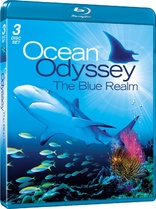
Movie rating
6.6 | / 10 |
Blu-ray rating
| Users | 3.0 | |
| Reviewer | 3.0 | |
| Overall | 3.0 |
Overview
Ocean Odyssey: The Blue Realm (2004-2008)
A natural history series about amazing creatures of the sea. Utilizing superb high-definition imagery, engaging stories and leading marine scientists, the series takes viewers on extraordinary journeys of discovery.
| Documentary | Uncertain |
| Nature | Uncertain |
Specifications
Video
Video codec: MPEG-4 AVC
Video resolution: 1080i
Aspect ratio: 1.78:1
Original aspect ratio: 1.78:1
Audio
English: Dolby Digital 2.0 (192 kbps)
Subtitles
None
Discs
25GB Blu-ray Disc
Three-disc set (3 BDs)
Playback
Region A (B, C untested)
Review
Rating summary
| Movie | 2.5 | |
| Video | 4.0 | |
| Audio | 3.0 | |
| Extras | 4.0 | |
| Overall | 3.0 |
Ocean Odyssey: The Blue Realm Blu-ray Movie Review
Under the Sea
Reviewed by Michael Reuben April 23, 2012Like some mammoth progenitor from the ocean depths, Jacques Cousteau spawned a thousand undersea documentarians, and the medium of hi-def has given them tools beyond anything Cousteau ever imagined. One such successor is Danny Mauro, whose first marine documentary, The Blue Realm, played in eight installments beginning in 2004 on Discovery HD Theater, Discovery Canada and National Geographic International. Image Entertainment and Madacy have issued the eight one-hour installments, along with a ninth hour that never aired and a small selection of bonus features, under the title Ocean Odyssey: The Blue Realm. Mauro and a cadre of divers and camera crew traveled the world to get their spectacular footage. Their locations included New Guinea, Palau in Micronesia, South Africa, the Red Sea, Australia's Great Barrier Reef, the Bahamas, Cocos Island in Costa Rica, British Columbia, Indonesia, the Socorro Archipelago of Mexico and, closer to home, Texas, California and Florida.
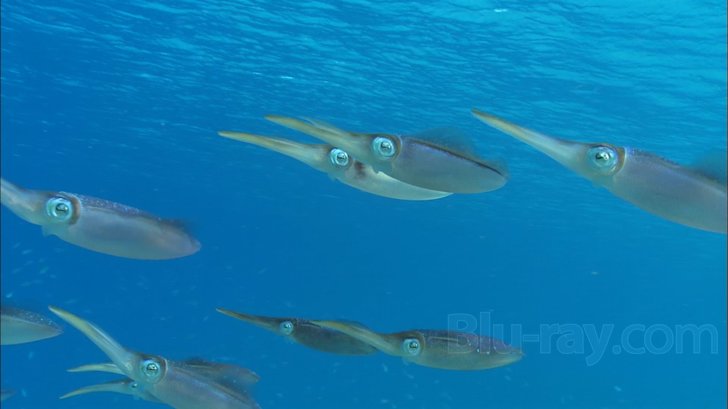
Episode 1: Shark Business The significance of the title is a growing trend in the diving world to encourage interaction between humans and sharks. (I would call this an "extreme sport", the kind that Bruno Kirby's Ed in City Slickers bullies his friends into joining him on holiday.) Mauro's camera takes us to several locations, including Australia and the Florida Keys, where these adventures are pursued. The Flordia locale is especially novel. There the proprietor of the tour attracts sharks with what they call a "chumsicle", a submersible barrel-shaped object composed of discarded fish remains that attracts the sharks and keeps them busy, while the divers look on and take photographs. Gary Adkison of Undersea Adventures proudly notes that they've never had an injury, even though children as young as four have participated in these dives and been just a few feet from the sharks. You may find yourself asking, as I did, what kind of parent thinks this is a good idea? Still, the overriding theme of the episode is that "the Jaws phenomena" is more myth than reality, that sharks are a crucial element in the ocean's ecosystem and that humans are an infinitely greater threat to sharks than sharks are to humans. The statistics quoted by the narrator make that last point hard to dispute. Episode 2: Venom The focus is on sea creatures that use toxins for both defense and offense. The main forms of marine life considered in detail are the sea snake, whose venom is more toxic to humans than that of most terrestrial snakes; the cone snail, which produces a powerful neurotoxin that is being closely studied for potential pharmacological breakthroughs; and the stone fish, one of the family of scorpion fish, which injects a venom causing such severe pain that victims have been known to beg for death. Of particular interest is an obscure species of jellyfish found only in a single lake in Palau, Micronesia. Once part of the ocean, the lake was isolated by seismic activity and became fresh water. The jellyfish evolved to survive in their new environment through a symbiotic relationship with a species of algae. No longer needing their toxic tentacles to paralyze and capture prey for feeding, they gradually lost their ability to produce poisons. Episode 3: Tentacles The squid and the octopus provide the most dramatic footage, but it's small reef squid that takes up most of the screentime. All of them are "cephalopods", which is type of mollusk that has evolved to exist without a shell and must therefore, as the narrator explains, be smarter to survive. Much of the episode is devoted to the painstaking research being conducted by a group of scientists led by Dr. Jennifer Mather (known in the world of marine biology as "the Jane Goodall of Calamari") into the complex communication among schools of reef squid, which can change color and body pattern instantaneously. Dr. Mather and her team believe that the reef squid has developed a genuine language of visual symbols that they have yet to decipher. Episode 4: Giants of San Benedicto (Manta Rays) San Benedicto is an island south of the tip of Baja, Mexico, and one of the largest habitats of giant manta rays, which are described at one point by the series narrator as "modified sharks". Like sharks, manta rays have body structures built on cartilage, but unlike sharks they have large brains. As described by Dr. Robert Rubin, the authority whose scientific inquiries provide much of the episode's narrative, manta rays are smart enough to distinguish one diver from another, even when they switch gear. Much about manta rays remains a mystery, and Rubin is one of the world's leading investigators. Their size and rate of growth is astonishing. The Atlantis Resort in the Bahamas kept a manta, which its keepers named "Bubbles", as part of their popular aquarium attraction. When Bubbles arrived, it was thirteen feet wide. Within a year, its width had expanded to fifteen feet, and Bubbles had outgrown the Atlantis tanks and had to be released into the wild. Like many of the creatures profiled in The Blue Realm, mantas are at risk from the fishing activities, though primarily as a side effect, since they are not desired by fisherman. They are now on the protected list. Episode 5: Whale Sharks: Gentle Giants Described as the largest fish in the sea, whale sharks are roughly the length and size of a bus but pose no threat to humans. Their diet consists of tiny marine creatures, and their giant mouths are missing the menacing rows of teeth commonly associated with sharks. Previously hunted for both their meat and their fins, they too are now a popular tourist attraction in both Mexico and Western Australia—so popular, in fact, that the crush of tourist threatens to scare off the whale sharks. Eco-tourism also has a potential downside. An alternative is the Georgia Aquarium in Atlanta, where the largest indoor tank in the world holds four whale sharks, along with other massive sea creatures. The footage documenting the extraordinary effort required to transport these huge marine animals to their new inland habitat gives some idea of the magnitude of the task, of which the aquarium representatives are justifiably proud. Episode 6: Shark Divers This episode is a sequel to episode 1, "Shark Business", and further explores the thrill-seeking sport of diving with sharks. Some of the adrenaline junky lunacy captured in this episode defies belief. Toward the end, a shark expert and a former triathlon competitor, both survivors of shark attacks, make the case that this “sport” has gone way too far, but they’re given short shrift. Episode 7: Manatees and Dugongs These two closely related creatures are the only aquatic mammals that are strictly vegetarians, and both are endangered species. Manatees are confined to the inland freshwater regions of Florida, while dugongs are more spread out, with major concentrations in the oceans near Australia and the Arabian coasts. The episode focuses on conservation efforts, especially for the manatee, whose popularity with eco-tourists and children has provided an effective rallying cry. Episode 8: Humpbacks: From Tonga to Antarctica The title is somewhat misleading, because the episode is less about the life cycle of humpback whales than the human treatment of these huge undersea mammals. Incorporating vintage footage of whaling operations, the narration recounts how the humpback was hunted to the brink of extinction before being declared a protected species. Then it recounts the international tug-of-war between those nations (primarily Japan) and commercial forces seeking to resume hunting humpbacks and conservationists opposed to the practice. Consistent with The Blue Realm's "eco-tourist" theme, the episode also explores the enormous popularity of "whale watching" expeditions, with special focus on Lahaina, Hawaii, where humpbacks are the main attraction. Almost a third of the episode is devoted to the activities of Captain Paul Watson and his Sea Shepherd Conservation Society, who are considered eco-terrorists by some because of their aggressive tactics against Japanese whaling ships. The graphic footage of Watson's ships' encounters with whalers in the Antarctic seas, most of which was not shot by Mauro, is remarkable.
Ocean Odyssey: The Blue Realm Blu-ray Movie, Video Quality 
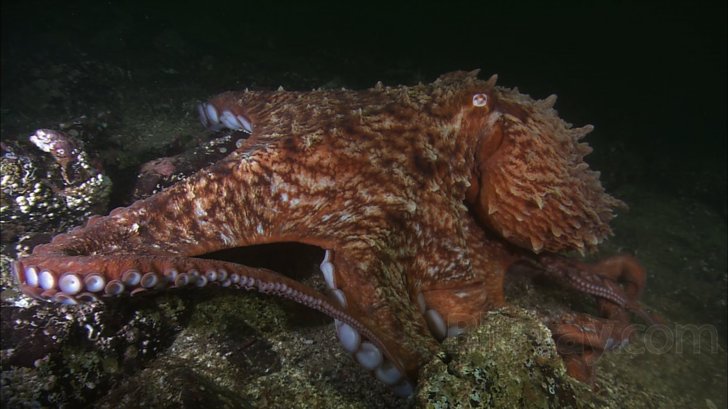
As series creator Mauro explains in one of the extras, he was among the first (if not the first) underwater photographers to adopt hi-def video. Mauro's experience with the format is reflected in the quality of the imagery on Image Entertainment's 1080i, AVC-encoded release of the series, which is clean, detailed and free of any noise or interference, except where archival sources have been incorporated (notably in the "Shipsinkers" bonus installment). The colors of the underwater marine life are frequently stunning in their vividness and variety, although it should be noted that colors vary significantly with surface conditions and depth, both of which affect the amount and type of light reaching the subject. Some of Mauro's images are so "up close and personal" that, with some of the less camera-friendly subjects (e.g., the venomous stone fish in episode 2), you may actually wish you were seeing less.
Ocean Odyssey: The Blue Realm Blu-ray Movie, Audio Quality 
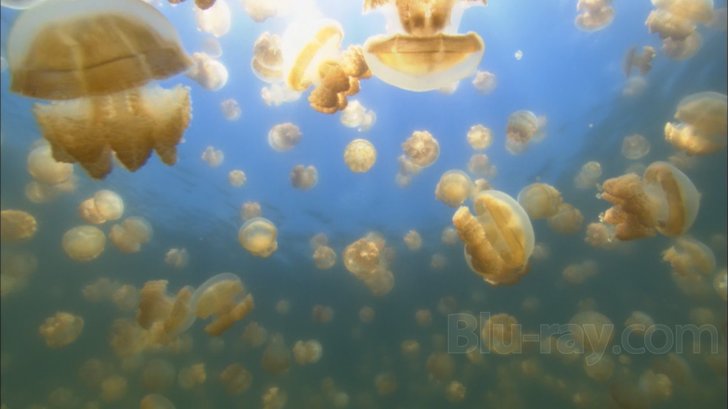
The show's stereo soundtrack is presented as Dolby Digital 2.0 at the standard DVD bitrate of 192 kbps. The key element to the soundtrack is the narration by Steve Downes, which is clear and well-articulated. The musical soundtrack, overseen by Tony Moskal, is varied and entertaining; when played through a matrix decoder, it expands nicely into the surround speakers to fill the listening space. Bass extension is acceptable, but the fidelity would no doubt have improved with either a higher bitrate or, preferably, lossless encoding. The audio track incorporates a surprising amount of production sound from the animals being photographed, although it is obvious that their noises have been isolated with directional microphones. In general, thought, the track is serviceable, well-mixed and gets the job done.
Ocean Odyssey: The Blue Realm Blu-ray Movie, Special Features and Extras 
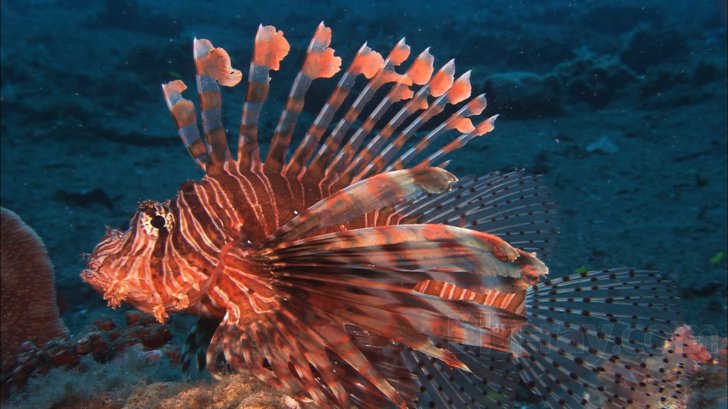
- The Shipsinkers (HD, 1080i; 1.78:1; 50:23): This bonus episode was not aired as part of the original series. It explores a unique form of "recycling" in which old ships, usually former naval vessels, are stripped down, decontaminated and scrubbed, then scuttled in strategically chosen locations where they serve as they foundation for artificial reef formations. The episode explores the practical and logistical challenges of this practice by closely tracking the activities of the team that sank the former battleship Wellington, now known simply as "F69", off the coast of Wellington, New Zealand. In addition to attracting marine life, sunken ships have proven to be an effective tourist attraction for scuba diving enthusiasts. To the program's credit, it includes observations from commentators who are concerned about using man-made structures to start marine colonies.
- Behind the Episodes (HD, 1080i; 1.78:1): In each of these clips, Mauro provides background on the individual episode.
- Shark Business (2:05)
- Venom (2:37)
- Tentacles (3:19)
- Giants of San Benedicto (2:14)
- Shark Divers (4:48)
- Whale Sharks: Gentle Giants (1:35)
- Manatees and Dugongs (3:28)
- Humpbacks: From Tonga to Antarctica (3:47)
- Slide Shows (HD, 1080i; 1.78:1): Each disc contains a slide show including stills from the episodes on that disc, plus, in some instances, behind-the-scenes photographs.
- Disc 1 (1:49)
- Disc 2 (1:49)
- Disc 3 (5:36)
Ocean Odyssey: The Blue Realm Blu-ray Movie, Overall Score and Recommendation 
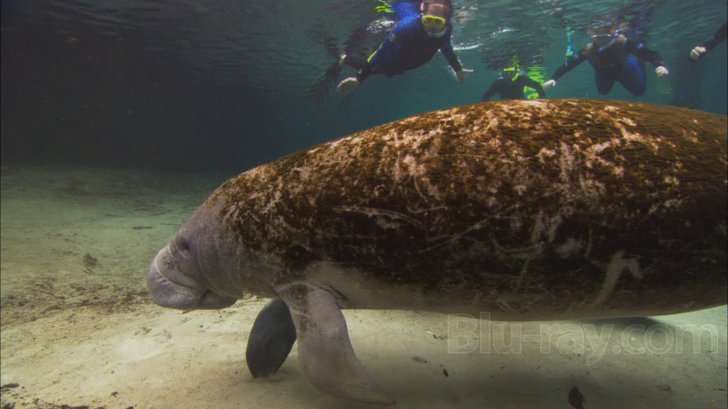
Though it includes some stunning imagery, Ocean Odyssey comes up short in providing detailed information about the various forms of marine life it covers. It opts more for eye candy and catchphrases over hard science and organized knowledge. Still, Mauro's images are sufficiently intriguing that they might entice a beginner, especially a young one, to further study. With that warning, and especially considering the low price, the three-disc set is recommended.
Similar titles
Similar titles you might also like

Shark Week: The Great Bites Collection
2008

Africa
2013

Hidden Kingdoms
2013

Water Life: The Big Blue
2008

Great White Shark: A Living Legend
2013

Madagascar
BBC
2011

Human Planet: The Complete Series
BBC
2011

The Blue Planet: Seas of Life
2001

Grand Canyon Adventure: River at Risk 3D
IMAX 3D
2008

Water Life: Planet Water
2008

Great Migrations
2010

Water Life: Water's Journey
2008

Great Barrier Reef
2012

The Great Rift
2009

Galápagos
2006

Wild Pacific
2008

Ganges
2007

One Life
2011

Planet Ocean
2012

Scenic National Parks: Yosemite
Combo Pack
2008